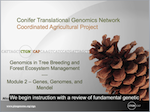Authors:
Nicholas Wheeler, Oregon State University; David Harry, Oregon State University; Heather L. Merk, The Ohio State University
Introduction
This module is about genes in populations. Some would argue the father of population genetics was Wilhelm Weinberg, a German physician who seemed equally comfortable with mathematics. Mendel actually made the first statement of a population’s genetic constitution under a system of mating (genotypic proportions following inbreeding). The real beginnings of the discipline might well be attributed to some early plant and animal breeders. In the 1700s, scientists like Fairchild, Mather, and Koreuter published on plant breeding (artificial hybridization, backcrosses, and F2s) and Bakewell laid the groundwork for many modern breeds of livestock, revealing the value of inbreeding to fix traits. Darwin and Mendel were influenced by these pioneer breeders. Darwin reflected on the effectiveness of artifical selection and extended the concept to natural selection. Mendel concentrated on the nature of hereditary determination. From these foundations two schools of study formed: the quantitative or biometric school, led by Galton and Pearson, and those who supported the inbreeding/crossbreeding principles of Mendel (Bateson and Castle). The differences between the groups were largely over the size of effects that were evolutionarily important. The Darwinians felt that small changes over great lengths of time were the essence of evolution. The breeders felt simple changes (allelic forms) could result in huge and immediate differences. Population genetics developed the means by which evolutionary forces could be modeled and described.
Module 3 – Population Genetics
See other Conifer Genomics Modules
You can also watch the video on YouTube.
References Cited
- Falconer, D. S., and T.F.C. Mackay. 1996. Introduction to Quantitative Genetics. 4th Ed. Pearson Education (Longman Group Ltd.), Essex, England.
- Hamrick, J. L., and M.J.W. Godt. 1990. Allozyme diversity in plant species. p. 43-63. In Brown, A.H.D., Clegg, M. T., Kahler, A. L., and B. S. Weir (ed.) Plant population genetics, breeding, and genetic resources. Sinauer Associates, Sunderland, MA.
- Hartl, D. L. 2000. A primer of population genetics. Sinauer Associates, Sunderland, MA.
- Hartl, D. L., and E. W. Jones. 2001. Genetics: Analysis of genes and genomes, 5th edition. Jones and Barlett, Sudbury, MA.
- Kimura, M. 1983. The neutral theory of molecular evolution. Cambridge University Press, New York.
- White, T. L, W. T. Adams, and D. B. Neale. 2007. Forest genetics. CAB International, Wallingford, United Kingdom. Available online at: http://bookshop.cabi.org/?page=2633&pid=2043&site=191 (verified 26 May 2011).
External Link
- Wikipedia contributors. 2011. Neutral theory of molecular evolution. Wikipedia, The Free Encyclopedia. Available at: http://en.wikipedia.org/w/index.php?title=Neutral_theory_of_molecular_evolution&oldid=421184222 (verified 26 May, 2011).
Cite This Learning Module
- Wheeler, N., and D. Harry. Population genetics [Online Learning Module]. Genomics in Tree Breeding and Forest Ecosystem Management, Conifer Translational Genomics Network. eXtension Foundation. Available at: https://plant-breeding-genomics.extension.org/population-genetics:-conifer-genomics-module-3/ (verified April 22, 2013).
Author Contributions
- Nicholas Wheeler and David Harry developed the learning module content.
- Heather Merk developed the webpage.
Funding Statement
Support for the Conifer Translational Genomics Network project and the development of the teaching modules hosted here was provided by the USDA/NRI CSREES Plant Genomics Coordinated Agricultural Project (CAP) Award # 2007-55300-18603, the USDA/NIFA AFRI Applied Plant Genomics CAP Award #2009-85606-05680 and the USDA Forest Service. Development of this page was supported in part by the National Institute of Food and Agriculture (NIFA) Solanaceae Coordinated Agricultural Project, agreement 2009-85606-05673, administered by Michigan State University. Any opinions, findings, conclusions, or recommendations expressed in this publication are those of the author(s) and do not necessarily reflect the view of the United States Department of Agriculture.
Attachments:
Population Genetics.pdf (2.02 MB)
PBGworks 1098

